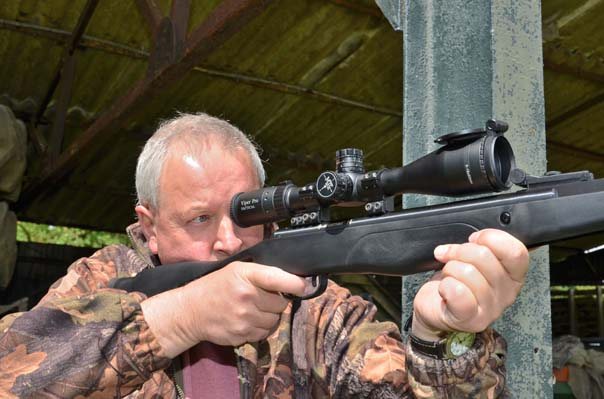CROSMAN F4 - A modern twist
- Last updated: 12/09/2024

Well, here we are. Welcome to Crosman’s F4; a stylish break-barrel that’s designed to appeal to shooters who want a traditional airgun with a modern twist. The sleek, black synthetic stock has plenty of detail designed in. Add in the large, full-length barrel shroud assembly and the result is a sporting airgun guaranteed to make an entrance!
And the action?
I must admit, I was initially confused with regards to the action, after taking a quick glance at Crosman’s website. Intriguingly, the F4 is shown as having a Nitro Piston action, but having spoken to Crosman’s UK distributors, Range Right, all UK-bound F4s will be spring-powered, simply because these are easier to keep below our UK power limit. Let’s not forget that the States has unrestricted airgun power levels, so basically anything goes! Back in good old Blighty, we have to walk a somewhat finer line, so Range Right has made a business decision to keep things simple. Suffice it to say, the Crosman F4 on test here, is very much spring-powered.
Features
Crosman’s sales blurb on the F4 mentions that it is ‘designed to offer a lighter and smoother cocking action than other rivals in its class’, and the other big feature is the full-length barrel shroud assembly that sits up front. Moulded and bonded around the barrel, externally, it is a single-piece synthetic shroud that looks stylish and feels good. Bear in mind that the actual rifled barrel is 15.75”, and the total length of the barrel and shroud measures 20.75”, meaning the final 5” is an expansion chamber with baffles. Crosman describes this muzzle configuration as ‘Quiet Fire Technology’, and whilst I’m not normally sold on silencers and muzzle calming devices on a springer, given how they are nowhere near as effective when compared to one fitted to a PCP, the setup on the F4 did seem to have an effect. More of which in a moment.
All weather?
The stylish synthetic stock is a tasty piece of design work. It’s ambidextrous for the record, and well-appointed. I love the raked, thinned-out grip, which, along with the thumbhole, makes for easy and comfortable handling. The forend is nicely shaped, with moulded stippling midway, and the pleasing rounded tip should feel good in the aim. The cheekpiece looked to me a tad low, but in use, it still did an adequate job of supporting the cheek while in the aim. Crosman describes this stock as ‘durable all-weather’, and while that is certainly true, the metal parts of the rifle may not appreciate being soaked! Practical though.
Initially, I opted to use the open sights, which do not have fibre optic elements. The finger wheel adjusters function well, and the overall image is very usable. Most shooters will inevitably gravitate to using a scope, so the dovetails and customary arrestor pre-drill on the receiver are ready for that purpose. I chose twin ring mounts and then bolted a Sportsmatch arrestor block in place, to kill any effect of recoil, but there are plenty of options.
In use
Right, ready to go. The barrel shroud assembly obviously has technical credentials as far as sound suppression, but on the range, it well and truly doubles up, coming into its own as a cocking aid. Those snazzy grooves around the muzzle section look the part, but they act as finger contours too, all contributing to the luxurious feel when breaking the barrel and cocking the action. A mild jolt is needed initially, to release the barrel. Thereafter, the action (as per Crosman’s boast) does feel ‘ultra-smooth’ through the cocking stroke, and with significant leverage afforded, it’s an extremely easy task to complete. The barrel lock-up is nicely weighted too, with a satisfying noise on completion. Just ensure that pellets are pushed flush in the breech, so as to avoid deformation as the breech closes. Standard stuff, but with quite a tight barrel on test, worth highlighting.
Trigger-wise, I’ve tested a few Crosman airguns of late, all with much the same trigger unit, and it’s a fair observation to say this unit is very basic. However, play the game, edge through the initial creep as the sears slide across each other, and then the final release is tolerable. Par for the course at the end of the day for this type of springer. There’s a fair amount of spring resonance on firing but the silencer configuration certainly seems to work, if my test range was anything to go by. Caught in mid-session, a blackbird landed on the grass, very close to the intended target. As I continued firing, it never moved, which says a lot for the sound suppression system. ‘Quiet Fire Technology’ is clearly the way forward!
Performance figures
I used a variety of ammo with this model, all with surprisingly similar results to be honest. Using Crosman Ultra Magnum pellets, I managed 1” groups over 30 yards, which is perfectly acceptable and very usable accuracy. Again, par for the course in this price sector. Further settling of the action would probably improve on that, as would extended pellet trials. Over the chronograph, the same ammunition posted a total velocity spread of just 16 fps, giving an average kinetic energy read-out of 11.3 ft/lbs, which is all very encouraging.
Conclusion
Overall, the Crosman F4 proved an enjoyable sporter, with plenty of character and a level of refinement in handling that sets it well above many entry-level rivals. Synthetic stocks are not to everyone’s taste, but that ‘tactical’ look and feel still holds great appeal for many. As for the front heavy ‘Quiet Fire Technology’, it makes for not only a dramatic profile, but it also appears to work!